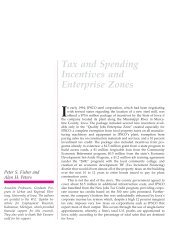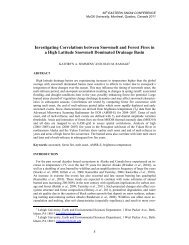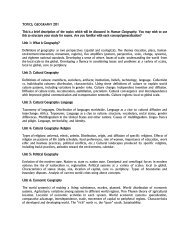PEOPLE ON THE MOVE - Department of Geography
PEOPLE ON THE MOVE - Department of Geography
PEOPLE ON THE MOVE - Department of Geography
Create successful ePaper yourself
Turn your PDF publications into a flip-book with our unique Google optimized e-Paper software.
The numbers were large: over 1 million immigrants arrived annually in 6 <strong>of</strong> the<br />
first 14 years <strong>of</strong> the 20th century. By the time <strong>of</strong> the 1910 Census, foreign-bom<br />
residents made up nearly 15 percent <strong>of</strong> the U.S. population and about 24<br />
percent <strong>of</strong> the U.S. Labor force.<br />
The 20th-century Trough: 1915-1964. Immigration ceased as war erupted in<br />
Europe, and remained low throughout World War I. When immigration started to<br />
revive in the 1920s, it was cut back again, first by sharp immigration restrictions<br />
and then by the Great Depression. Easing <strong>of</strong> legal restrictions began after World<br />
War n, but legal immigration stayed at about 250,000 per year until the 1960s,<br />
when changes in immigration law allowed larger flows. Immigrants from Mexico<br />
and other Western Hemisphere nations accounted for one-third <strong>of</strong> the 1 million<br />
immigrants who arrived <strong>of</strong>ficially during the 1940s. Between 1940 and<br />
1960,360,000 legal Mexican immigrants were admitted, and another 1 to 2<br />
million worked temporarily as Braceros in U.S. agriculture. The number <strong>of</strong> illegal<br />
entries from Mexico during this period is not known. The U.S. border patrol<br />
located and deported over 1 million Mexicans in the infamous "Operation<br />
Wetback in the mid 1950s. However, some <strong>of</strong> those deported were later found<br />
to be U.S. citizens or legal residents.<br />
The Fourth Wave: 1965 to the Present. The fourth wave <strong>of</strong> immigrants began<br />
arriving in the United States after 1965, when a new law altered the preference<br />
system from one that selected immigrants on me basis <strong>of</strong> their national origins,<br />
reserving most places for northern and western Europeans, to one that gave<br />
priority to people with family members already in the United States or who had<br />
skills needed in the U.S. Labor market. This change, coupled with prosperity in<br />
Europe, changed the composition <strong>of</strong> U.S. immigration. During the 1970s, Europe<br />
sent less than 20 percent <strong>of</strong> U.S. immigrants; Mexico contributed nearly the same<br />
share. During the 1980s and early 1990s, Europeans were about 10 percent <strong>of</strong><br />
legal immigrants, while Asians made up about one-third and Hispanics nearly onehalf<br />
<strong>of</strong> the decade's immigrants.<br />
The immigration waves at the beginning and end <strong>of</strong> the 20th century have many<br />
similarities, even though the national origins <strong>of</strong> immigrants differ. Over 1 million<br />
immigrants arrived annually during the peak immigration years in the early<br />
1900s, about the same level as in the early 1990s. Both waves brought large<br />
numbers <strong>of</strong> people whose national origins, religions, languages, and cultures are<br />
significantly different from those <strong>of</strong> the American majority. Deep-seated concerns<br />
about the newcomers during the third and fourth waves prompted reassessments<br />
and reforms <strong>of</strong> U.S. immigration policies. Now one in every 11 Americans is<br />
foreign-born.
















